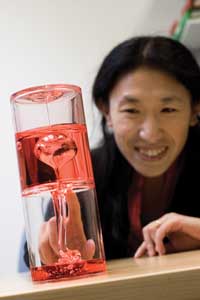Air bubbles experiment could lead to new nanotech fibers
By Steve KoppesNews Office
 Wendy Zhang, Assistant Professor in Physics and the College, is perfecting a technique that could lead scientists to develop extremely thin wires for use in biomedical and biotechnology procedures. | |
The behavior of air bubbles in ordinary breakfast syrup demonstrates how scientists might be able to make vanishingly thin tubes and fibers for biomedical and other applications.
Previous experiments conducted in Professor Sidney Nagel’s laboratory showed how to make liquid threads that measure only 10 microns in diameter (approximately one-fifth the diameter of a human hair). Now Nagel’s colleague Wendy Zhang has reported in the Friday, Oct. 29 issue of Physical Review Letters that it is theoretically possible to make much thinner threads by slightly altering experimental procedures. If proven in the laboratory, the technique has potential use in fiber optics, electronics and other industries.
“There are many people who are trying to use this idea, or ideas like this, to make very thin wires,” said Zhang, Assistant Professor in Physics and the College. “They’re very interested to know what’s the smallest size that they can achieve.”
The calculation Zhang devised to answer that question indicates there is no theoretical limit to the thinness of a thread produced via fluid flow. But the calculation does not account for the microscopic building blocks of matter. In reality, she said, a thread cannot be thinner than the molecules of which it is made.
A professor of engineering who specializes in the physics of fluids, Alfonso Gañán Calvo of the Universidad de Sevilla in Spain believes Zhang’s work could have “an enormous impact in fields from biomedicine and biotechnology to the hot nanotech industry. In my opinion, this great work will open wide new avenues for the controlled production of extremely thin and long holes in materials like polymers, glasses and ceramics,” he said.
This line of research began for Zhang in the laboratory of Nagel, the Stein-Freiler Distinguished Service Professor in Physics and the College. Nagel has made what he calls “physics at the breakfast table” one of the hallmarks of his research. When Nagel introduced Zhang to his experiments in the flow of viscous fluids several years ago, “I was completely enchanted,” she said.
Despite the whimsical breakfast theme, serious issues lurk behind Nagel’s work. He, along with Milan Mrksich, Professor in Chemistry, and Marc Garfinkel, Assistant Professor in Surgery, are working on a precisely controlled method of fluid flow to protect transplanted insulin-producing cells from the body’s immune system.
The team has successfully coated small clumps of cells, but Zhang wondered if the same technique could be used to coat individual cells, or even smaller irregularly shaped particles. This requires that liquid spouts of even smaller radii be created.
An ordinary bottle of syrup demonstrates the principle of viscous entrainment, the topic of Zhang’s paper. If you turn a bottle upside down, a large air bubble slowly rises to the top. “With a long enough bottle, the rising movement can distort the bubble so severely that it takes on a tear-drop shape, with a thin tendril of air being drawn out from the rear,” she explained.
The phenomenon illustrates how the flow in syrup naturally creates small, extended structures—in this case the trailing tendril of air, Zhang said. To make this tendril smaller than the 10-micron limit that Nagel and his associates have observed in the laboratory, they would need to constantly adjust the pressure on the back of the tube to keep the shape of the interface between the fluid and the air at the front always the same.
“It’s an odd way to do the experiment. It’s not something that a good experimentalist would do just for the heck of it because it’s inconvenient and there’s no obvious payback,” Zhang said. “But if the idea is right, there is a payback.”
A method that already exists, called electrospinning, can make microscopically thin fibers. But Zhang noted that viscous entrainment has advantages over electrospinning. For example, electrospinning was recently adapted to create hollow fibers. This requires the use of two liquids, one for the sheath and one for the core, and then the removal of the core. “There is a possibility that viscous entrainment would work directly with air, so you could do the entire processing in one step,” Zhang said.
Today her idea exists only as a calculation in a scientific journal. It remains to be seen whether it will work in practice. “You don’t know until someone’s actually used it,” she said.
![[Chronicle]](/images/sidebar_header_oct06.gif)